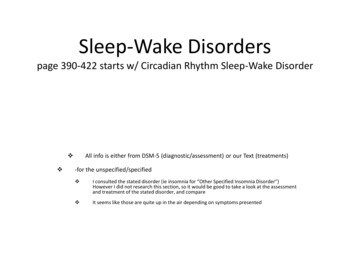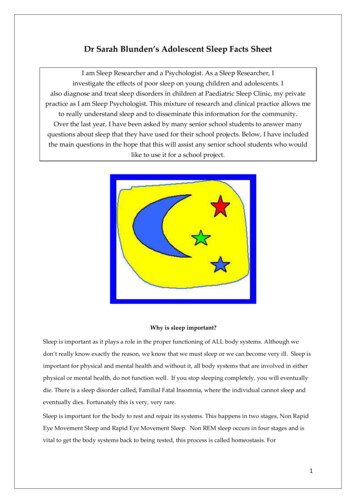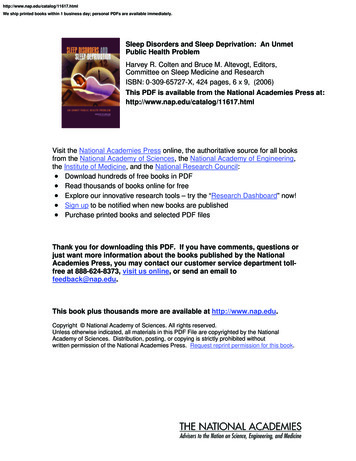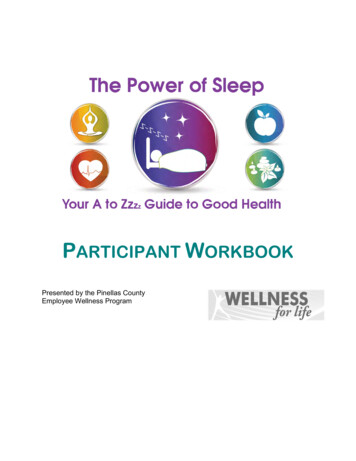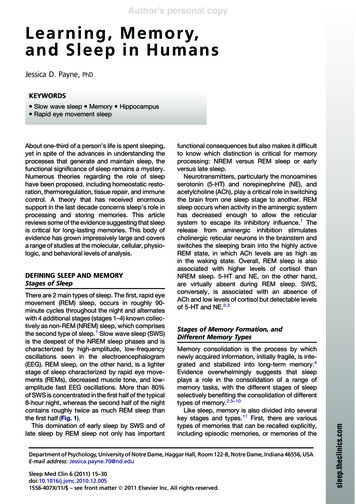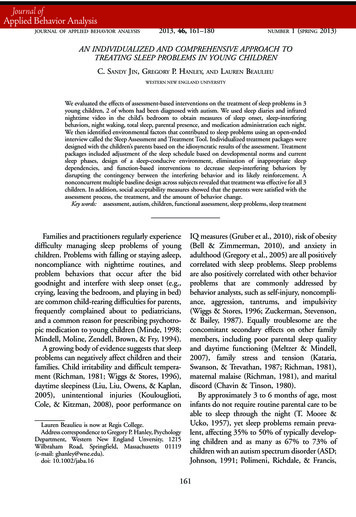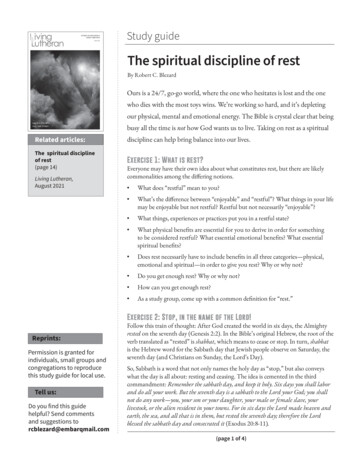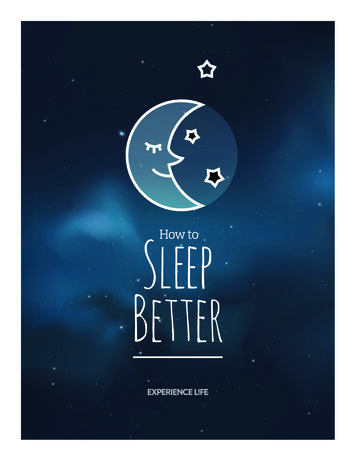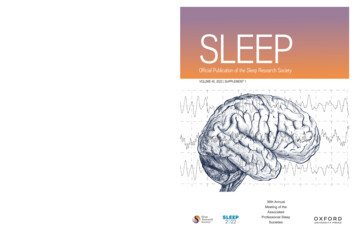
Transcription
SLEEPSLEEPOfficial Publication of the Sleep Research SocietyVOLUME 45, 2022 SUPPLEMENT 1VOLUME 45(S1) 2022 PAGES A1–A40636th AnnualMeeting of theAssociatedProfessional SleepSocieties
SLEEPOfficial Publication of the Sleep Research SocietyVolume 45, Supplement 136th Annual Meeting of the Associated Professional Sleep Societies
SLEEPJOURNAL OF SLEEP AND SLEEP DISORDERS RESEARCHVolume 45 Supplement 1 May 19, 2022 Pages 1–406Official publication of the Sleep Research Socitety.Editor-in-ChiefAllan Pack, MBChB, PhDDeputy Editors-in-ChiefKatie Stone, PhD David M Gozal, MD Antoine Adamantidis, PhDExecutive DirectorJohn A. NoelAssociate EditorsSara Aton, PhDAlon Y. Avidan, MD, MPHSara J. Aton, PhDFiona Baker, PhDSteven Brown, PhDMichael W. L. Chee, MD, PhDRonald D. Chervin, MDStephanie Crowley, PhDThien Thanh Dang-Vu, MD, PhDChristopher Drake, PhDSean Drummond, PhDJulio Fernandez-Mendoza, PhDRaffaele Ferri, MDJames E. Gangwisch, PhDPhilip Gehrman, PhDNamni Goel, PhDDaniel J. Gottlieb, MD, MPHReut Gruber, PhDAndrew D. Krystal, MDLeon Lack, PhDNathaniel Marshall, PhDJennifer Martin, PhDMiguel Angel Martinez-Garcia, PhDBabak Mokhlesi, MDCharles M. Morin, PhDMilena Pavlova, MDJohn Peever, PhDDavid Raizen, MD, PhDFrank Scheer, PhDRichard J. Schwab, MDMariana Szklo-Coxe, PhDLynn-Marie Trotti, MD, MScEus J. W. Van Someren, PhDKenneth P. Wright Jr., PhDThomas Penzel, PhDMichael L. Perlis, PhDDante Picchioni, PhDGina R. Poe, PhDHengyi Rao, PhDTimothy A. Roehrs, PhDAsya Rolls, PhDJared Saletin, PhDPaula K. Schweitzer, PhDKazue Semba, PhDPaul J. Shaw, PhDRenee Shellhaas, MD, MSPriyattam J. Shiromani, PhDMichelle Short, PhDAdam Spira, PhDRobert Stickgold, PhDMarie-Pierre St-Onge, PhDKingman P. Strohl, MDAriel Tarasiuk, PhDRobert J. Thomas, MDLiat Tikotzky, PhDAdrienne Tucker, PhDChrista J. Van Dort, PhDSigrid C. Veasey, MDOlivia J. Veatch, MS, PhDVladyslov Vyazovskiy, PhDArthur S. Walters, MDEmerson Wickwire, PhDJonathan P. Wisor, PhDAmy R. Wolfson, PhDJames K. Wyatt, PhDJacek K. Urbanek, PhDMeredith L. Wallace, PhDWei Wang, PhDJoshua F. Wiley, PhDEditorial BoardMonica L. Andersen, PhDJ. Todd Arnedt, PhDRashmi Aurora, MDM. Safwan Badr, MDSiobhan Banks, PhDCelyne H. Bastien, PhDDean W. Beebe, PhDBei Bei, PhDRichard B. Berry, MDBjorn Bjorvatn, MD, PhDDonald L. Bliwise, PhDOrfeu Buxton, PhDJulie Carrier, PhDPeter Catcheside, PhDPhillip Cheng, PhDYves Dauvilliers, MD, PhDSusanne Diekelmann, PhDJeffrey Donlea, PhDLeslie C. Dort, MSc, DDSJeanne F. Duffy, PhDGalit Levi Dunietz, PhD, MPHBradley Edwards, PhDConstance Fung, MDPeter C. Gay, MDMichael A. Grandner, PhD, MRT,CBSMMonica Haack, PhDRosemary S. Horne, PhDReto Huber, PhDAlex Iranzo, MDShahrokh Javaheri, MDDayna Johnson, PhDAthanasios Kaditis, MDLeila Kheirandish-Gozal, MDThomas S. Kilduff, PhDChristopher Kline, PhDGerrit Lammers, MDSoomi Lee, PhDMiranda M. Lim, MD, PhDPeter Y. Liu, MBBS, PhDSteven W. Lockley, PhDFaith Luyster, PhDBryce A. Mander, PhDJanna Mantua, PhDGeorge Mashour, MD, PhDGeert Mayer, MDW. Vaughn McCall, MDThomas A. Mellman, MDDavid N. Neubauer, MDSeiji Nishino, MD, PhDPhilippe Peigneux, PhDStatistical Editorial BoardBrandan Keenan, PhDKwang-Youn A. Kim, PhDRobert T. Krafty, PhDJune C. Lo, PhDStefania Mondello, MD, MPH, PhDLucia Peixoto, PhDDale L. Smith, PhD 2022 Sleep Research Society.
Table of ContentsAbstracts by CategoryXVII.Sleep and Neurodegeneration A119A. Basic and Translational Sleep andCircadian ScienceAbstracts 0264–0282XVIII.Sleep Deprivation, Loss, and Extinction A128I. Behavior and Performance A1Abstracts 0283–0303Abstracts 0001–0023II. Cell and Molecular Biology and Genetics A11B. Clinical Sleep Science and PracticeAbstracts 0024–0035I. Adults: Sleep and Aging, Sleep and Gender A137III. CircadianRhythmsMechanismsandPhysiology A17Abstracts 0304–0334Abstracts 0036–0038II. Circadian Rhythm Sleep-Wake Disorders A151Abstracts 0335–0339IV.COVID-Related Sleep Disruptions A19Abstracts 0039–0054III. Consumer Technology A153Abstracts 0340–0353V. Disparities in Sleep and Circadian Health A26Abstracts 0055–0080IV. Healthcare Delivery and Education A160Abstracts 0354–0382VI. InnovationsinSleepandCircadianTechnologies A37V. Central Disorders of Hypersomnolence A172Abstracts 0081–0104Abstracts 0383–0420VII. Learning, Memory, and Cognition A48VI. Insomnia A188Abstracts 0105–0125Abstracts 0421–0482VIII. Neurobiology A57VII. Pediatrics A214Abstracts 0126–0134Abstracts 0483–0545IX. Occupations, School, and Sports A61VIII. RLS, Movement Disorders, and Parasomnias A241Abstracts 0135–0144Abstracts 0546–0559X. Physiology A66IX. Sleep and Medical Disorders A247Abstracts 0145–0154Abstracts 0560–0622XI. .Population and Demographics A72X. Sleep and Neurologic Disorders A274Abstracts 0155–0165Abstracts 0623–0646XII. Sleep and Arousal A77XI. Sleep and Psychiatric Disorders A285Abstracts 0166–0174Abstracts 0647–0694XIII.Sleep and Chronobiology Across theLifespan A81XII. Sleep-Related Breathing Disorders A305Abstracts 0695–0796Abstracts 0175–0193C. Case ReportsXIV.Sleep and Circadian Biomarkers A89Case Reports from Clinical Trainees A346Abstracts 0194–0199Abstracts 0797–0864XV.Sleep and Circadian Rhythms A92IndexesAbstracts 0200–0228Author Index A372Keyword Index A396XVI.Sleep and Emotion, Stress, and Trauma A104Abstracts 0229–0263iiSLEEP, Volume 45, Supplement 1, 2022
EDITORIALWelcome to your preview of SLEEP 2022, the 36thAnnual Meeting of the Associated Professional SleepSocieties, which is scheduled to be held in Charlotte, NorthCarolina on June 4-8, 2022.This abstract supplement unites the journal SLEEP,and the science of SLEEP 2022. All abstracts presented atSLEEP 2022 are included in this special issue. This year 864abstracts will be presented at the meeting. 196 will be presented in an oral presentation format, and the remainder willbe presented in a poster format. Many authors of oral presentations will also be presenting their science in the virtualposter hall, providing additional time to network with theauthors of these important studies. In addition, this abstractsupplement contains case reports submitted by individualsin Sleep Medicine Fellowship and other training programs.Abstracts in this supplement are divided between Basicand Translational Sleep Science, and Clinical Sleep Scienceand Practice and then assigned to one of 30 subcategories.Each abstract has a unique four-digit number to facilitateidentification and location both within this issue and atSLEEP 2022. The four-digit number in the abstract supplement matches the four-digit code published in the SLEEP2022 Mobile App.The SLEEP meeting fosters an environment in whichmembers and attendees learn about the latest basic, translational, and clinical science and technologies, promoting thecontinued growth of the field through the dissemination ofnew knowledge. This will be our first time that SLEEP isheld in person since the beginning of the pandemic. We lookforward to seeing everyone and sharing in the success of thispivotal event and hope you consider joining the AmericanAcademy of Sleep Medicine and Sleep Research Society inCharlotte, North Carolina in June.Allan I. Pack. MBChB, PhDEditor-in-ChiefiiiSLEEP, Volume 45, Supplement 1, 2022
A. Basic and Translational Sleep and Circadian Science I. Behavior and Performance0001procrastination is an important target for interventions to promoteadequate sleep, yet the social cognitive, biological, and behaviouraldeterminants of bedtime procrastination are poorly understood.The present study aimed to conduct a systematic review, narrativesynthesis, and meta-analysis of (1) the underlying determinants ofbedtime procrastination, and (2) the strength and direction of therelationship between bedtime procrastination and sleep outcomes.Methods: A database search was conducted through CINAHL,EMBASE, PsychINFO, PubMed, Scopus and Web of Science,using keywords related to procrastination, delay, bedtime and sleep.Results: A total of 2087 records were identified, and 38 publicationsmet the inclusion criteria. Random-effects meta-analysis for bedtime procrastination and sleep outcomes is ongoing. Preliminaryfindings suggest self-regulation, self-control and chronotype arethe most prominent determinants.Conclusion: Future research should expand focus to identify abroader range of determinants. Given that there are multiple benefits to a theory-based approach to behaviour change interventions,further research exploring determinants will be able to guide thedevelopment of interventions targeting bedtime procrastination.Support (If Any):ASSOCIATIONS BETWEEN CIRCADIAN FACTORSAND TRAVEL DISTANCE WITH PERFORMANCE:A RETROSPECTIVE ANALYSIS OF 2014-2018 NATIONALBASKETBALL ASSOCIATION DATAJesse Cook1, Jonathan Charest2, Olivia Walch3, Amy Bender4University of Wisconsin-Madison, Department of Psychology,Madison, WI, USA 1 University of Calgary, Faculty of Kinesiology 2University of Michigan, Department of Neurology 3 Cerebra 4Introduction: Frequent travel across time zones and travelling longdistances interferes with healthy sleep and disrupts the circadiansystem, often degrading athletic performance. National BasketballAssociation (NBA) players face a demanding travel schedule oftenrequiring multiple games per week, with games spanning the continental United States. This investigation aimed to clarify the influence of circadian factors and travel distance on NBA performanceusing a dataset from the 2014-2018 seasons.Methods: NBA (2014-2018) game data were acquired from anopen-access source: om-2014-to-2018). Circadian variables of time zone change(TZ ) and adjusted jet lag (AJL) were formulated, with quadraticversions utilized across analyses. TZ captured circadian delay/advance based on travel for a game, with each TZ going eastward andwestward reflected by -1 and 1, respectively. AJL advances TZ by allowing acclimation to a novel TZ, with each day resulting ina 1-unit change towards circadian neutral. AJL is a season-longrolling summation, which was computed using two different travelapproaches: Approach1 (AJL1) assumes travel the day before eachgame, whereas Approach2 (AJL2) was designed to prioritize beinghome. A standardized flight tracker determined travel distance foreach game (GameDistance). Team ability differences, characterized as difference in season win percentages (SeasonWinPerDiff),served as an analytic covariate. Game point differential (PointDiff),defined as a team’s score minus their opponent’s score, and a team’sfree throw percentage (FreeThrowPer) served as outcome variables.Linear mixed-effects modeling assessed univariate and multivariateassociations, with games nested within both team and year.Results: AJL2 (β -0.63; p .01) and GameDistance (β -0.73;p 0.0001) significantly associated with PointDiff. TZ (β -0.002;p .03), AJL1 (β -0.002; p .04) and GameDistance (β -0.003;p 0.007) significantly associated with FreeThrowPer. AJL2 andGameDistance maintained significant relationship with PointDiffin fully adjusted model that included AJL2, GameDistance, andSeasonWinPerDiff.Conclusion: Results suggest that both circadian delay/advanceand greater distance traveled for games negatively influence NBAperformance, even when controlling for differences in team ability.Season travel and flight plans could be constructed to reduce theeffects of circadian misalignment and travel distance.Support (If Any): None0003ON THE SAME WAVELENGTH? QUANTIFYING THEASSOCIATIONS BETWEEN EATING TIMING AND RESTACTIVITY RHYTHMS IN FREE-LIVING ADULTSElissa Hoopes1, Michele D'Agata1, Talia Brookstein-Burke1,Shannon Robson1, Melissa Witman1, Susan Malone2, Freda Patterson1University of Delaware 1 New York University 2Introduction: Misalignment between the central circadian clockand daily behaviors increases cardiometabolic morbidity and mortality risk, likely due to internal misalignment between centraland peripheral circadian rhythms. Experimental studies suggestfood intake may act as a time cue (‘zeitgeber’) for resetting circadian rhythms, representing a potential behavioral target to ameliorate circadian misalignment and associated health consequences.However, the extent to which eating timing relates to circadianrhythms in free-living adults is unclear. Therefore, we tested theassociations between eating timing with 24-h rest-activity-rhythms(RAR), a free-living proxy for endogenous circadian rhythms, innon-shift-working adults.Methods: Adults without chronic health conditions or sleep disorders completed 14 days of 24/7 wrist accelerometry to evaluateRAR variables of interdaily stability (IS; day-to-day stability inRAR), intradaily variability (IV; within-day fragmentation ofRAR), relative amplitude (RA; difference between peak vs. troughactivity), L5 onset time (5-h period with lowest activity), and M10onset time (10-h period with highest activity). Concurrently, timestamped image-assisted diet records were obtained to generateaverage eating timing variables, including daily eating onset (timeof first caloric intake after awakening), offset (last caloric intaketime), duration (time elapsed between eating onset and offset), andcaloric midpoint (time at which 50% of daily kcals were consumed),and variables illustrating irregularity in eating timing (standard deviation of eating timing variables). Pearson’s correlations quantified the associations between RAR and eating timing variables.Results: Participants (N 30) were 28.0 6.6 years, 57% female,with a BMI of 23.8 2.5 kg/m2. Higher IS was correlated withlower irregularity in both eating onset (r -0.55, p 0.01) and duration (r -0.51, p 0.01). Higher RA correlated with earlier eatingonset (r -0.47, p 0.01), longer eating duration (r 0.53, p 0.01),and lower eating onset irregularity (r -0.37, p 0.05). Later L50002GO TO BED! A SYSTEMATIC REVIEW AND METAANALYSIS OF BEDTIME PROCRASTINATIONDETERMINANTS AND SLEEP OUTCOMES.Vanessa Hill1, Sally Ferguson1, Amanda Rebar1, Alexandra Shriane1,Grace Vincent1Central Queensland University 1Introduction: Bedtime procrastination, the volitional delay ofgoing to bed without any external circumstances causing thedelay, is associated with poor sleep outcomes. Alleviating bedtimeA1SLEEP, Volume 45, Supplement 1, 2022
A. Basic and Translational Sleep and Circadian Science I. Behavior and PerformanceSupport (If Any): Military Operational Medicine ResearchProgram under work unit N2010.correlated with later eating onset (r 0.67, p 0.001), offset (r 0.58,p 0.001), caloric midpoint (r 0.56, p 0.01), and greater eatingoffset irregularity (r 0.53, p 0.01). Later M10 correlated withlater eating offset (r 0.40, p 0.05).Conclusion: Preliminary findings indicate that eating timing andRAR are moderately correlated in free-living adults. Earlier eatingtiming, increased eating regularity, and longer daily eating durationmay represent behavioral targets for improving circadian rhythmsand subsequent cardiometabolic outcomes.Support (If Any): Support provided by the American HeartAssociation (#831488) and a University of Delaware ResearchFund-Strategic Initiative Award.0005BIDIRECTIONAL ASSOCIATIONS OF SLEEP ANDALCOHOL USE WITHIN AND BETWEEN REGULARLYDRINKING YOUNG ADULTSDavid Reichenberger1, Anne-Marie Chang1, Michael Russell1The Pennsylvania State University 1Introduction: Young adults can be resistant to drinking interventions, but improving other health behaviors, such as sleep, mayindirectly reduce hazardous drinking. Evidence linking sleep tonext-day drinking among regular drinkers could support sleepinterventions as an indirect pathway to alcohol misuse reduction.We investigate this connection in the natural environments of 222regularly drinking young adults.Methods: Regularly drinking young adults (21-29 years; 63%women) wore an alcohol monitor across six days that continuouslymeasured transdermal alcohol concentration (TAC). Participantscompleted daily smartphone-based surveys reporting the previousnight number of drinks and sleep. Predictors were disaggregatedinto within- and between-person variables. Sleep variables wereused to predict next-day alcohol use, and alcohol use variables wereused to predict subsequent sleep. Multilevel Poisson and linearmodels with random intercepts for each outcome were adjusted forweekends, sex, weight, and prior night sleep/drinking.Results: Between-person results showed that participants whotended to go to bed later had on average 24% more drinks (p 0.01)and achieved 26% higher peak TAC (p 0.02) the next day. Everyhour of sleep duration the prior night was associated with a 14%decrease in the number of next-day drinks (p 0.03). Conversely,participants who drank more went to bed on average 12-19 minuteslater (p 0.01) and slept 5 fewer minutes (p 0.01). Within-personresults showed that on nights when participants drank more thanusual they went to bed 8-13 minutes later (p 0.01), slept 2-4 fewerminutes (p 0.03), and had worse sleep quality (p 0.01).Conclusion: Young adults who went to bed earlier and slept longeron average tended to use alcohol less the next day, and using lessalcohol tended to improve subsequent sleep within young adults.Taken together, these results suggest that better sleep health mayimprove drinking behaviors and intoxication dynamics, which mayhave implications for interventions targeting sleep as a mechanismto reduce heavy drinking.Support (If Any): David Reichenberger was supported by thePrevention and Methodology Training Program (T32 DA017629)with funding from the National Institute on Drug Abuse(NIDA). This research was funded by departmental funds anda pilot mentoring and professional development award throughP50DA039838 (NIDA), both awarded to Michael Russell.0004SLEEP, TEAM AND SOCIAL PROCESSES, AND HEALTH,PERFORMANCE, AND SAFETY IN NAVAL OPERATIONALENVIRONMENTSPeter Roma1, Jason Jameson1, Andrew Kubala1, Rachel Markwald2,Dale Russell3Naval Health Research Center Leidos Inc. 1 Naval Health ResearchCenter 2 Commander, Naval Surface Force, US Pacific Fleet 3Introduction: Sleep disruption and teamwork are inherent featuresof 24/7 operational environments, yet little is known about howsleep and team/social processes interact to affect crew readinessand endurance.Methods: We analyzed data of 3,434 active duty US sailors(80% male) from the Afloat Safety Climate Assessment Survey.Using structural equation modeling, we specified latent factorsof Sleep Health (typical hours of sleep per day and sleep disturbances in shipboard environment); crew team and social factors of Team Transition Processes, Team Action Processes, TeamInterpersonal Processes, Unit Cohesion, Psychological Safety, andSocial Support; and operational outcome risks of Physical Health(no. days in previous 30 with physical illness or injury), MentalHealth (no. days with stress, depression, or emotional problems),Performance (frequency of fatigue-induced functional impairments on duty), and Safety (individual and crew noncompliance,and rate of observed near misses).Results: Higher Sleep Health reduced impairments in PhysicalHealth, Mental Health, Performance, and Safety (standardized βs 0.096 to 0.542, ps 0.0001, CFI/TLI 0.980,RMSEA 0.033). Higher Sleep Health improved Team Transition,Action, and Interpersonal Processes, Unit Cohesion, PsychologicalSafety, and Social Support (βs 0.178 to 0.380, ps 0.0001, CFI/TLI 0.982, RMSEA 0.029). Social Support reduced risksto Physical Health, Mental Health, and Performance; TeamInterpersonal Processes reduced Metal Health risk; PsychologicalSafety reduced Performance and Safety risks; Unit Cohesion reduced Safety risk (βs 0.053 to 0.709, ps 0.05, CFI/TLI 0.979, RMSEA 0.027). Mediation models indicated good SleepHealth enhances Social Support’s beneficial impact on PhysicalHealth, Mental Health, and Performance; Psychological Safety’simpact on Performance and Safety; Team Interpersonal Processes’impact on Physical Health; and Unit Cohesion’s impact on Safety(indirect effect βs 0.032 to 0.127, ps 0.0001, CFI/TLI 0.967, RMSEAs 0.051).Conclusion: Sleep health improves team/social functioning, whichserves an additive protective function and enhancement to crewoperational health, performance, and safety. Future work shouldclosely examine these interrelationships to identify mechanisms astargets for policy and procedures to help optimize crew readinessand endurance.SLEEP, Volume 45, Supplement 1, 20220006AN AT-HOME EVALUATION OF A LIGHT INTERVENTIONTO MITIGATE SLEEP INERTIA SYMPTOMSCassie Hilditch1, Gregory Costedoat1, Sean Pradhan2,Nicholas Bathurst3, Zachary Glaros3, Kevin Gregory3, Nathan Feick1,Nita Shattuck4, Erin Flynn-Evans5San Jose State University 1 Menlo College 2 NASA 3 NavalPostgraduate School 4 NASA Ames Research Center 5Introduction: Sleep inertia symptoms typically occur after wakingfrom nocturnal sleep. Under laboratory settings, light exposureupon waking has been shown to improve alertness, mood, andA2
A. Basic and Translational Sleep and Circadian Science I. Behavior and Performanceof nights between days of interest (min), age (months), sex (maleor female), and socioeconomic status (index). Preliminary modelsincluded interactions with nap habituality (rarely, sometimes, orfrequent).Results: Occurrence of a nap was not associated with next-daywake behaviors and previous-day wake behaviors did not predictnap duration. However, on days children napped, they were less sedentary (B -2.09, p 0.001) and more active (B 25.8, p 0.001) thefollowing day. Nap habituality did not moderate these associations.Conclusion: Bidirectional associations between nap sleep and daytime wake behaviors were not evident. While daytime movementbehaviors were not predictive of nap sleep, napping was beneficially associated with subsequent-day movement behaviors in preschool children. Further studies could explore specific nap sleepmetrics in samples with more diverse sleep health, as well as consider the reason for daytime napping.Support (If Any): NIH R01 HL111695vigilant attention. We investigated whether a field-deployablelight-emitting device would help to improve alertness and workingmemory in a real-world setting.Methods: Thirty-five participants (18 female; 26.4 6.0 y) completed an at-home, within-subject, randomized crossover study.Participants wore actiwatches during their normal sleep-wakeschedule for five nights ahead of the adaptation and experimentalnights. On the experimental night, participants performed baselinetesting before their self-selected bedtime. Forty-five minutes afterbedtime, participants received a phone call and were instructedto perform test bouts while wearing light-emitting glasses withthe light either on (light condition) or off (control). A 3-minutedescending subtraction task (DST) and the Karolinska SleepinessScale (KSS) were performed at 7, 17, 27, and 37 minutesafter the call. Participants were then instructed to go back to sleepand were called 45 minutes after lights out to repeat the test boutsin the opposite condition. A series of mixed-effects models wereperformed with fixed effects of condition, test bout, and their interaction, and a random effect of participant. Condition order, sex,and baseline were included as covariates.Results: There was a significant effect of test bout for DST total responses (χ2 [3] 17.42; p .001) and total correct (χ2 [3] 21.29;p .001) with improved performance at 27 and 37 minutescompared to 7 minutes. Sex was a significant predictor for KSS(F1,30 10.26; p .003), with females (8.20 0.23) rating highersleepiness than males (7.10 0.25). There were no other significanteffects for DST or KSS outcomes (p .05).Conclusion: These results suggest that the intervention was notable to improve working memory or alertness under naturalisticat-home settings. Further analysis is needed to determine whetherthese results are applicable to other cognitive performance domains.Support (If Any): Funded by the Naval Postgraduate School, viathe Naval Medical Research Center's Naval Advanced MedicalDevelopment Department (MIPR N3239820WXHN007), withsupport from the NASA Airspace Operations and Safety Program,System-Wide Safety.0008UNIVERSITY-WIDE CHRONOTYPING SHOWS LATE-TYPESTUDENTS HAVE LOWER GRADES, SHORTER SLEEP, ANDMORE ABSENTEEISMSing Chen Yeo1, Jacinda Tan1, Clin Lai2, Samantha Lim1,Yuvan Chandramoghan1, Joshua Gooley1Duke-NUS Medical School 1 National University of Singapore 2Introduction: A person’s preferred timing of nocturnal sleep(chronotype) has important implications for cognitive performance. Students who prefer to sleep late may have a selective learningdisadvantage for morning classes due to inadequate sleep and circadian desynchrony. We tested whether late-type students performworse only for morning classes, and we investigated factors thatmay contribute to their poorer academic achievement.Methods: Chronotype was determined objectively in 33,645university students (early, n 3,965; intermediate, n 23,787;late, n 5,893) by analysing the diurnal distribution of their loginson the university’s Learning Management System (LMS). Linearmixed models were used to test for differences between chronotypegroups in grade point average (n 33,645), actigraphy-estimatedsleep behaviour (n 261), and class attendance estimated usingWi-Fi connection data (n 17,356).Results: Late-type students had lower grades than their peers forcourses held at all different times of day, and during semesters whenthey had no morning classes. Actigraphy studies confirmed LMSderived chronotype was associated with students’ sleep patterns.Nocturnal sleep on school days was shortest in late-type studentsbecause they went to bed later than the other chronotype groups andwoke up earlier compared with non-school days. Wi-Fi connectionlogs for classrooms revealed that late-type students had lower lectureattendance than their peers for both morning and afternoon classes.Conclusion: Large university-archived datasets can be used toassess relationships between chronotype and academic performance. Late-type students had lower grades, shorter sleep, and weremore likely to miss classes. Shifting classes later may improvesleep and circadian synchrony in late-type students. However,this probably will not eliminate the performance gap becausethey still had lower grades when they only had afternoon classes.Interventions that focus on improving students’ well-being andlearning strategies may be important for addressing the late-typeacademic disadvantage.Support (If Any): Data storage and management were supportedby the NUS Office of the Senior Deputy President & Provost and0007TEMPORAL ASSOCIATIONS BETWEEN ACTIGRAPHYMEASURED DAYTIME MOVEMENT BEHAVIORS ANDDAYTIME SLEEP IN EARLY CHILDHOODChristine St Laurent1, Jennifer Holmes1, Rebecca Spencer1University of Massachusetts Amherst 1Introduction: Although napping in early childhood is associatedwith some cognitive and behavioral outcomes, less is known aboutrelations with physical health measures. Lower levels of sedentarybehavior and higher levels of physical activity have been beneficially associated with sleep measures in adults. Studies exploringsleep and daytime movement behaviors (sedentary time and physical activity) in young children have had inconsistent results andprimarily focused on overnight sleep. The purpose of this microlongitudinal analysis was to determine if: 1) daytime movementbehaviors predicted the likelihood of napping the next day, 2) daytime movement behaviors predicted next-day nap duration, and3) the occurrence of a nap predicted next-day movement behaviors.Methods: In 240 children (age 50.8 9.8 months, 49.2% female)sedentary time (% of wake time), total physical activity (counts/min), and nap duration (min) were derived from wrist-basedactigraphy (mean 9.7 days), and occurrence of a nap was recordeddaily. Multilevel logistic and linear models with lagged effects wereused to examine temporal within-person relations between wakebehaviors and nap sleep, and adjusted for night’s sleep durationA3SLEEP, Volume 45, Supplement 1, 2022
A. Basic and Translational Sleep and Circadian Science I. Behavior and Performanceof N 1,007 working-age adults from southeastern Pennsylvania.Bed Sharing was assessed with survey items assessing frequencyin the past month of sharing a bed with a partner/spouse, child/children, pet(s), other family member(s), or nobody (sleepingalone). Other sleep health factors assessed included InsomniaSeverity Index, Brief Index of Sleep Control, Epworth SleepinessScale, Fatigue Severity Scale, STOP-BANG apnea score, sleepduration, sleep latency, and wake after sleep onset. Mental healthfactors included PHQ9 depression score, GAD7 anxiety score,Multidimensional Scale of Perceived Social Support, PerceivedStress Scale, and global ratings for overall life satisfaction and relationship satisfaction. Covariates included age, sex, race/ethnicity,income, and education.Results: Compared to those who reported “Never,” those whoshared a bed with a pa
Miguel Angel Martinez-Garcia, PhD Babak Mokhlesi, MD Charles M. Morin, PhD Milena Pavlova, MD John Peever, PhD David Raizen, MD, PhD Frank Scheer, PhD Richard J. Schwab, MD Mariana Szklo-Coxe, PhD Lynn-Marie Trotti, MD, MSc Eus J. W. Van Someren, PhD Kenneth P. Wright Jr., PhD Editorial Board Monica L. Andersen, PhD J. Todd Arnedt, PhD Rashmi .
